Kurume Ramen (Fukuoka Pref.)
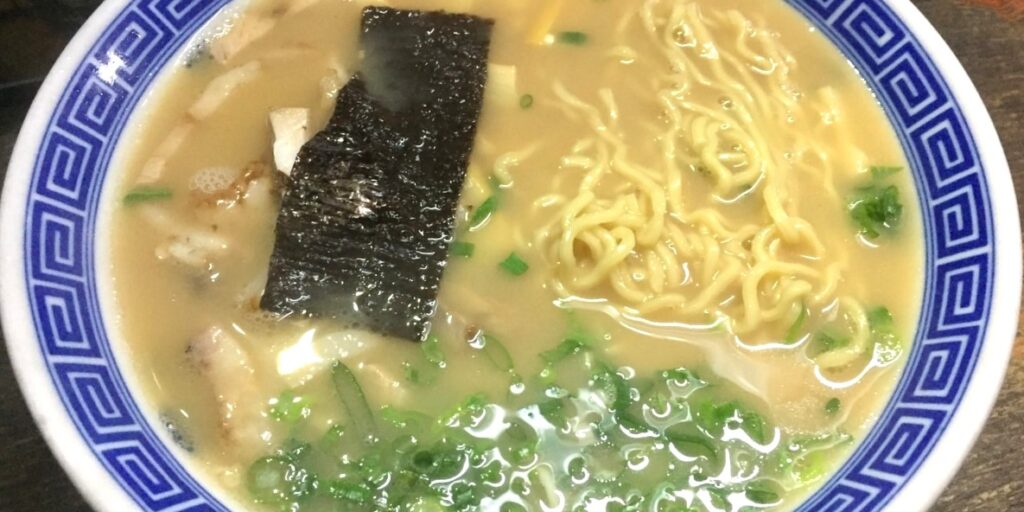
What is Kurume Ramen(久留米ラーメン)?
Kurume Ramen is a type of pork bone ramen served mainly in Kurume City(久留米市), Fukuoka Prefecture.
It is the birthplace of cloudy pork bone soup, and its noodles are slightly thick and straight, and its ingredients include wood ear fungus, chashu pork, and nori. Sometimes an ingredient called “karikari(カリカリ)”, which is fried pork fat, is used.
The soups are basically pork bone-based, but there is a wide variety of soups, from light to rich and thick, and each store has its own characteristics.
Additionally, Kurume ramen soup is made using a method called “callback(呼び戻し Yobimodoshi; Replenishment of soup)” that continues simmering while adding back the remaining amount, and often uses a Hagama pot(羽釜; broad-brimmed cooking pot), which has good heat conductivity.
At Nagahama Ramen in Hakata, the ramen is made using a method called “Torikiri(取りきり),” in which the soup is prepared in a pot and used up every day.
Roots of Kyushu Ramen
Most ramen in Kyushu is a cloudy soup based on pork bones, and Kurume is the birthplace of this cloudy soup.
First, in 1937, “Nanking Senryo(南京千両)” was established as a food stall in front of Nishitetsu Kurume Station. It’s surprising that it’s still in the same location and with the same taste. However, “Nanking Senryo(南京千両)” itself is based on the taste of Yokohama’s Chinatown, and the soup is not cloudy. If you look at it, it’s soy sauce ramen. Although it is a Kurume ramen shop, it is not the Kurume ramen that is commonly known.
So, where and how did cloudy soup come into being? It all started with the food stall “Sankyu(三九)”. One day in 1947, shop master went shopping without lowering the heat of soup, and tried seasoning the soup, which had become cloudy due to overcooking, and found that it was delicious. Kurume ramen, like the cloudy white soup at Ide Shoten(井出商店), a Wakayama ramen shop, was also a product of chance.
There is a theory that Hakata’s “Aka Noren(赤のれん)”, which was founded in 1946, is the origin of cloudy soup.
“Sankyu(三九)” ramen would later influence Kumamoto, Oita, Kitakyushu, Miyazaki, etc., so the origin of cloudy tonkotsu soup is said to be “Sankyu(三九)” in Kyushu as a whole.
Now, Kurume Ramen is said to be the origin of the cloudy soup, but it lags behind Hakata and Kumamoto in terms of popularity. If you’re wondering if it’s inferior in taste, I don’t think that’s the case. This may be due to differences in advertising methods and strategies for expanding into the metropolitan area.
Even in the Tokyo metropolitan area, in recent years “Kairyu(魁龍)” (Kurume Ramen, although it is located in Kokura; north Fukuoka Pref.) has opened a shop at the Shin-Yokohama Ramen Museum, and the brand is expected to spread in the future. You can expect it.
“Tairyu Ramen(大龍ラーメン)” is definitely popular among locals. The soup made from pork head slowly cooked over high heat is irresistible. You can also get the same taste online, so if you can’t go, give it a try.
Another dish that is also popular is “Taihou Ramen(大砲ラーメン).” Founded nearly half a century ago, this shop is known for its soup made over and over again while replenishing(commonly known as “callback(呼び戻し)”), which is relatively light in Kurume. The second generation, Hitoshi Kazuki(香月均), took over the business and began opening multiple shops, expanding to Hakata and Shin-Yokohama Ramen Museum and becoming a famous shop brand nationwide.
Maruboshi Ramen(丸星ラーメン), open 24 hours a day for drivers, served more than 1,000 bowls of ramen every day for 350 yen(※now 550yen in 2024). Also, don’t miss the cafeterias “Oki Shokudo(沖食堂)” and “Hirose Shokudo(ひろせ食堂).” All of these ramen were in the 300 yen range.
The biggest difference between Kurume and Hakata was whether or not they had seaweed(海苔 Nori) and whether or not they had kaedama(替玉 another helping of noodles). Many shops in Kurume use seaweed, and there are almost no kaedama. The kaedama system is said to have been invented in the fishing town of Nagahama. Nowadays, the Kaedama system used in Hakata and Nagahama is also sometimes used in Kurume, so the difference is becoming thinner.
Kurume ramen soup is made using the callback Yobimodoshi method, so it can have a strong odor. This is said to be the effect of fermentation and ripening by heat-resistant bacteria, and is similar to fermented foods such as cheese and yogurt.
Dairyu Ramen 大龍ラーメン (Ramen)
Rich pork bones that are popular in Kurume. A soup made with slowly simmering pork head. The noodles are homemade. Green onions are organic.
Taihou Ramen Kamitsu Branch(Showatei) 大砲ラーメン上津店(昇和亭) (old time ramen)
Old Ramen is a retro-style restaurant that recreates the flavors of the food stalls from nearly half a century ago.
Oki Shokudo 沖食堂 (Ramen)
Although it looks rich, it is surprisingly light. In the past, it was available for around 300 yen. As of 2024, it is 600 yen.
Ramen-Japan / Examples of Ramen Shops
Examples of the long-established Kurume ramen shops
-
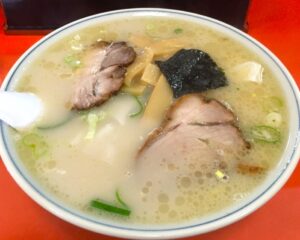
-
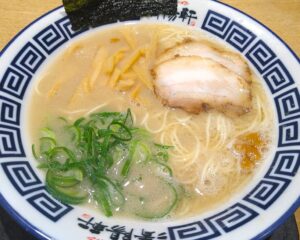
-

-
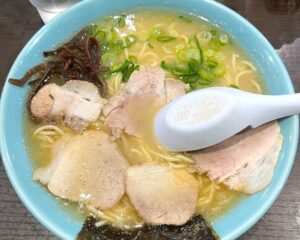
-
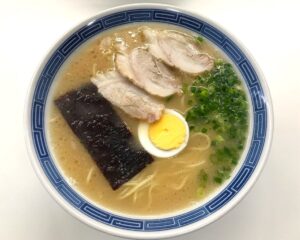
Oki Shokudo(沖食堂) *Founded in 1955. Other than ramen, rice balls with beans are popular.
-

-
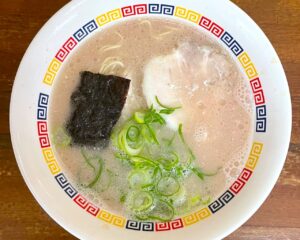
-
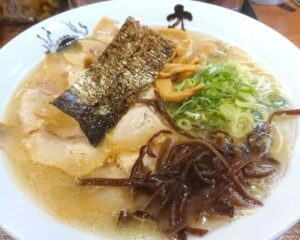
-
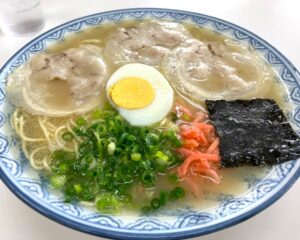
Maruko Shokudo(丸好食堂) *Established in 1966. A long-established cafeteria. Champon is also popular.
Examples of popular Hakata ramen shops
-
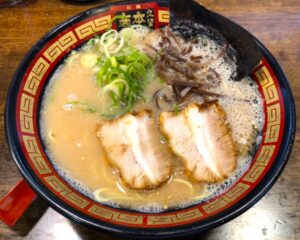
-
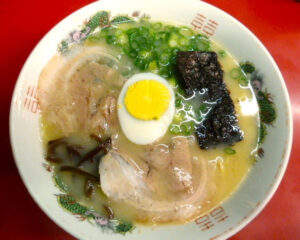
Kurumeya(久留米屋) *Founded in 1973. From the stall. Oden is also popular.
-
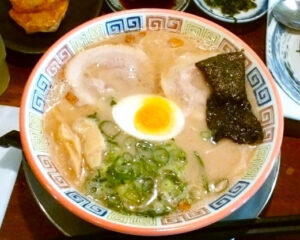
-
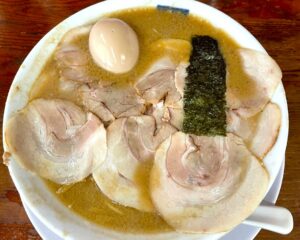
-
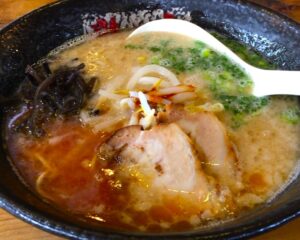
Tatsunoya Kamitsu Shop(龍の家 上津店) *“Kokuaji(こく味)” uses garlic and charred onion flavored oil.
-
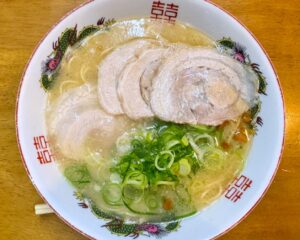
-

-
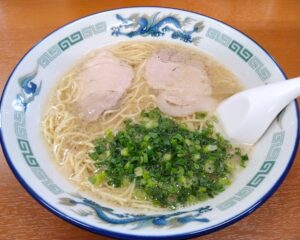
Ramen Hachi(らーめん八) *Dazaifu Hachcchan lineage. Listed as a 2019 Michelin Plate.
-
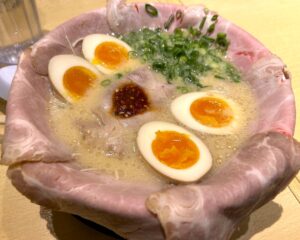
Mohican Ramen Hakata Deitos Shop(モヒカンラーメン 博多デイトス店) *Kurume soup and Hakata noodles.
-
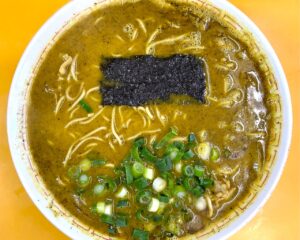
Taihou Ramen(大峰ラーメン) ※There are ramen, champon, curry champon, and curry ramen.
-
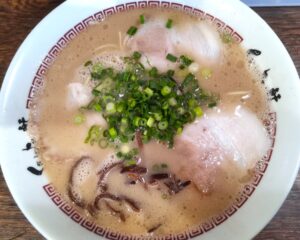
Kuiyoiken(くいよい軒) *The classic Kurume pork bone ramen. The fried rice set is popular.
-
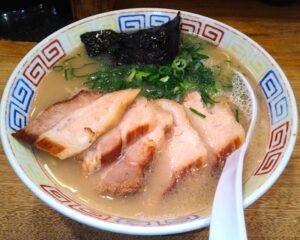
Examples of Kurume ramen shops in the metropolitan area
-
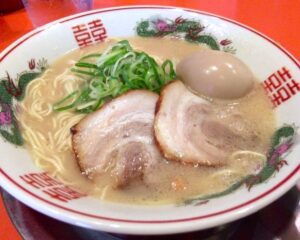
-

Tonkotsu Ramen Kurumeya(豚骨ラーメン くるめや) *Authentic Kurume tonkotsu ramen. You can also buy it online.
-
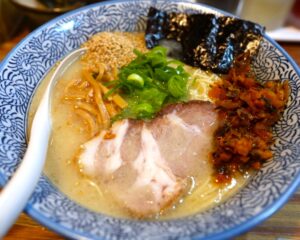
Kurume Ramen Kinmaru(久留米らーめん 金丸) *Kurume Ramen that can be enjoyed in Ginza.
-
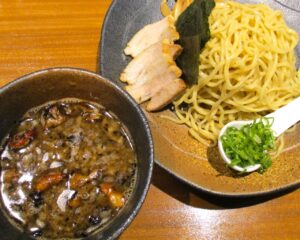
-
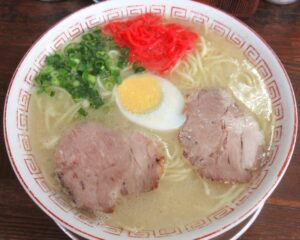
Kyushu Ramen Ishi(九州ラーメン いし) *A Kurume ramen shop founded in 1973.
-
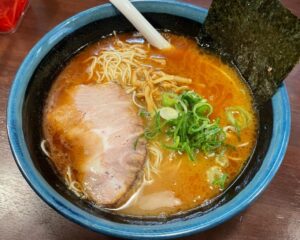
Motomaru(もとまる) *Free refill noodles. A popular shop open until late at night.
